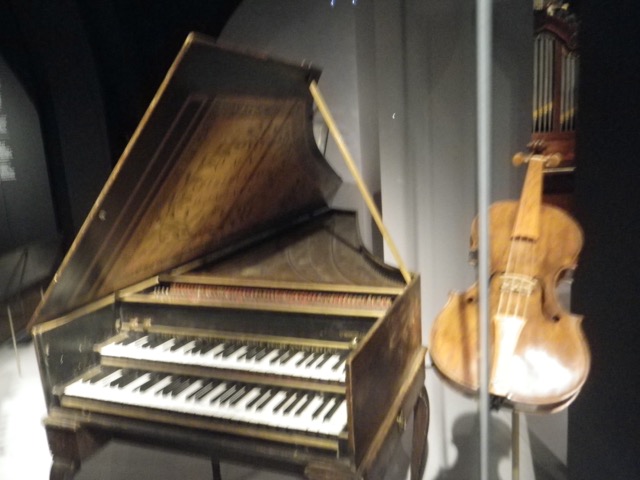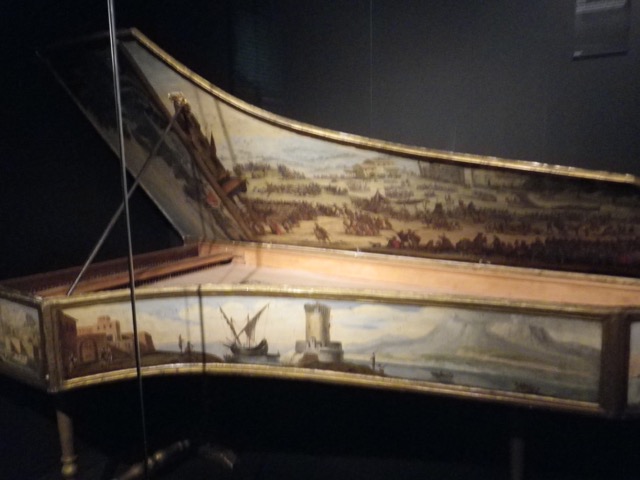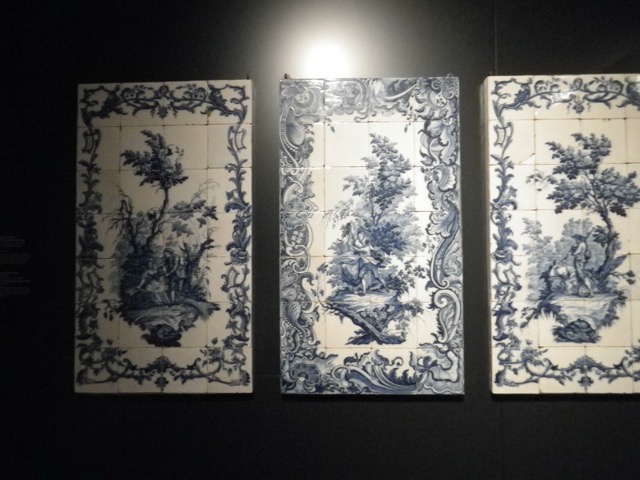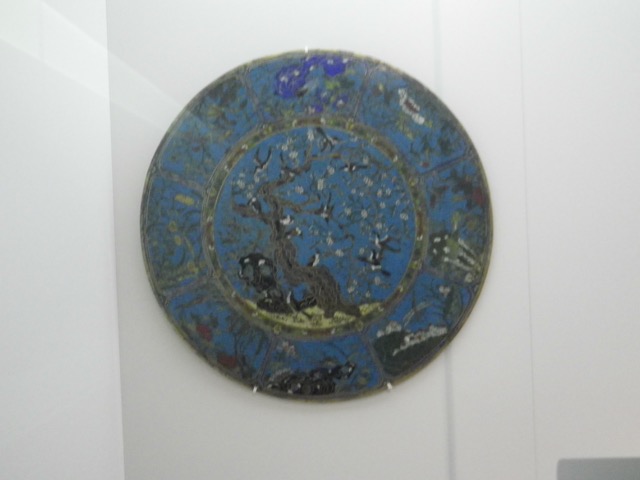Work went super fast this morning and at noon, I had an 1.5 hours left to do. I was torn between finishing and then heading later to the Rijksmuseum, or going to the Rijksmuseum for a few hours as a break, then coming home to finish. The latter choice felt more logical as I would have a solid four hours to see the museum. I suspected I only needed to spend two hours there, but I didn’t know how bad the queue would be to get in. Since the job was easy and I’m so well rested these days, I could finish up at my leisure before a later dinner.
It was really cold today, with frost on the grass in the square outside my flat and at the park I cut across to get to the Museum Quarter. Rather pretty!
I wandered around the Museum Quarter for a bit and found a street lined with stores featuring expensive designers.
The Chanel store was rather pretty, faced with clear green glass tiles.
There are a bunch of food stands on the plaza between the Van Gogh Museum and the Rijksmuseum. I’ve been pricing burgers for a bit and the burger I got here wasn’t cheap at 6 euros, but it was decent value for Amsterdam and tasty. It got cold fast, though! 🙂
I went next door and got a cafe cortado, which came with little cookies exactly like I fell in love with at the Mediterranean place in Sarajevo, and which was just 2.10 euros! I would never have guessed I’d find the best value of coffee so far in Amsterdam right on the Museumplein.
The lineup to get into the Rijksmuseum was interminable, a sharp contrast to the day I took this picture:

I got into the special line for folks who don’t need to go to the ticket desk. It wasn’t nearly as long as the regular line and it moved much more quickly. Can’t say the same for the coat check line and I kicked myself for forgetting I could have gotten a locker instead.
Since I’d already done a fast tour of the Rijksmuseum, I had a much better and more efficient plan of attack for today. I first headed to the special ground floor exhibits. I had no trouble getting in a second time with my Museumkaart, but some folks with a different card were told they had to get a ticket since their card was not scannable. The ticket was free, but they could not jump the queue to get it. I was devastated for them.
Like in so many museums, you can’t use a flash at the Rijksmuseum, so I’m going to try to be discerning and not show too many blurry ones.
So The ground floor has exhibits from 1100 to 1600, as well as special exhibits, where I started.
The first special exhibit I visited was the model ships. These were built true to life at miniature scale in the 19th century, a time when the technology of shipbuilding was growing in leaps and bounds thanks to such inventions as the steam engine. These scale models could be used to explain innovations to a lay person and to aid in the building of the full size models.
This is the figurehead from the frigate Prins van Oranje. As you can see, it’s a man in full armour.
A lighthouse model:
I wasn’t that interested in the gun gallery (armoury), but I learned that “the Netherlands was once a leading centre for the production and trade of arms.” I have to say that some of the guns were works of art.
Then, I went to the pottery exhibit, one of my favourite parts of the whole museum. It’s actually broken into two parts, with other exhibits mixed in.
Blue and orange together make me happy.
This coffee and tea service shows that the application of enamel colours to porcelain was still a great challenge in the 1700s as evidenced by the fact that some of the pieces are more purple than pink.
This was an interesting object. It is a necklace made of four pieces of stovepipe. Surely meant as a concept and not something to wear!
The musical instruments were also works of art. They were mixed in with a few other exhibits as well.
Love this bat pin.
And the dragonfly pin. Lovely detail on the comb.
A group of violins.
The lute (I think) that has a face is a hoot!
One of the things that enchanted me on my first visit was the Magic Lantern exhibit. These were the earliest forms of modern projectors. Images on plates of glass were projected. When the plates were changed in rapid succession, you got a moving picture. Very cool! They date back to the mid-1600s!
Here are some magic lantern plates.
We got to see one in motion. The arms on this windmill appeared to be moving.
I then went into the Delftware (blue on white) exhibit, which had tiles and other decorative objects as well as practical items.
This is a roulette board.
This tile panel with a vase of flowers would have been fitted into a fireplace to give it interest when there was no fire burning.
I loved this dish with pomegranates and grapes because of the unusual colour choices the painter made. The grapes are orange and the pomegranates are blue and white.
This is a game box.
This is a beaker of ice glass, “an effect achieved by plunging the blown glass while still white-hot into cold water in order to produce cracks. When the glass is reheated and blown further, these cracks get bigger.”
There was a display of boxes.
Locks and keys:
There was an exhibit all about miniature silver things. Here are some mocked up in a dollhouse:
“Around 1700, porcelain vases of this size were extremely rare and prestigious.”
Coming back out of the model ships, I spotted this one. See the little figures on the deck? They are holograms! They were 3D and moving around. I’d never seen anything like it.
Next up was the exhibit about the Middle Ages, which I was not impressed with when I went through last time as it’s all religious art and objects. Yes, I know that was the theme of the day, but there was art that showed common life as well. So I rather blipped through this part of the museum.
Loved the colours on this painting:
A scene depicting the St. Elizabeth Day Flood.
The only known portrait of a black man in early European painting. He may have been been one of Charles the V’s archers, Christophie le More.
The ground floor of the Rijksmuseum has a picnic area for school groups and those with their own lunches. Look at that vaulted ceiling!
The Asian exhibit is tucked way in the back on its own. I don’t think people would know it’s there unless they studied the floor plan.
I loved the exhibit of kimonos.
This one was particularly unusual.
I was really impressed with this figure on my first visit. Look at the eyes!
I love Japanese pottery.
The museum has modern parts added to the old. So this would have been an exterior wall once upon a time.
Behind it was an exhibit of interesting photographs that did not photograph well. They were of collages of objects. The effect had a 3D texture that seemed innovative.
I would later see many more cabinets in this style. I think this is my favourite.
I headed up this back, almost secret, staircase to see the exhibits from 1700 to 1900.
There was a very cool light fixture that would “blossom” as it dropped down.
I wasn’t the only one who as mesmerised by it!
The staircase is really lovely. Shame its hidden away in a corner like that.
I watched the lights from the top for a bit.
Hope you can play this video!
There was more Asian pottery in the stairwell.
Next up was an exhibit of taxidermy about all the exotic critters Dutch explorers encountered.
Boa constrictor:
Capybara, an animal that is so exotic to me it might as well be a unicorn.
A llama.
So soft! I can now understand what all the fuss is about petting llamas!
Yes, that was allowed! 🙂
This entire hilarious sign is worth reading.
The museum has lost a lot of its period charm outside of what was once the main entrance, but you get the odd burst of it.
An Italian scene under umbrella pines.
A scene in the Rhine Valley. I can’t believe I remember that.
Pretty goblet.
This painting reminded me of the paint by numbers “style.”
I saw a couple more Van Goghs! This is Undergrowth:
One woman and her daughter came up to this one and said it must be Van Gogh. I knew it absolutely wasn’t, so I translated the sign for them (they only spoke French). The artist was, however, inspired by Van Gogh. The mother said that it was odd how the top is classical Dutch artwork, like dark like Rembrandt, and the bottom is Van Gogh. I explained that Van Gogh started in that darker style and then moved to the lighter, so this painting was rather like looking at the evolution of Van Gogh’s style. I hope she goes to the Van Gogh Museum!
Some wandering around later, I climbed up what had once been the entrance staircase to go see the exhibits from 1600 to 1700, including the Rembrandts and the Vermeers. There is beautiful stained glass in this part of the museum.
And more vaulted ceilings.
Looking out into the main hall of the museum where you don’t need a ticket. Yes, this is an interior space.
The hall is gorgeous. I’m glad I got this picture last time as there were too many people today to make such a shot possible!

This painting depicts a breech of the dam. I love how your attention is drawn to that bright red cape billowing in the wind and conveying the drama of the scene.
Now, a hodgepodge of stuff.
Another incredible cabinet. Pretty sure this was made from hundreds of tiny pieces of wood in different colours.
Not sure if these incredible items had a function.
This enamelled violin was just a decorative object and could not be played.
Just wow…
More wow.
I would love a four-poster bed with a canopy. 🙂
Another incredible cabinet.
The painter of this red ibis with an egg was my kind of woman. Her name was Maria Sibylla Merian (1647-1717) and she was an artist and a naturalist. In 1699, when she was 52 and divorced, she and her youngest daughter sailed to Suriname!
Grey as it is, I really love the drama of this one.
Rembrandt’s famous Night Watch:
Vaulted ceiling in the great room holding the Rembrandts and the Vermeers.
Vermeer’s The Milkmaid. To be honest, I don’t remember learning about Night Watch in my art classes, but I definitely remember discussing The Milkmaid and how the milk being poured is the only sign of movement in the whole thing.
Another mosaic in the entrance hall floor.
This cheap crown was meant to be a gift for the King of Ardra on the west coast of Africa, but it never reached him.
Here is one of those box beds I saw at Rembrandt’s house, only his were proper cabinets with doors that shut.
A crib.
A map of the Iberian Peninsula. The bright blue lapis lazuli has faded to grey.
I loved these stained glass windows!
Her crooked eye is a lovely human detail.
Two oaks.
Another one of Rembrandt’s famous paintings.
Yet another magnificent linen cabinet. Just be grateful I’m not showing you them all!
William II, 14, and his bride, Mary Stuart, 9.
A hat with a bullet hole in it.
I was happy to see imperfect items on display.
Vases.
A composition of exotic fruits.
A feast of turkey pie.
The olives are so life-like.
As is the fruit.
Next, I headed upstairs to the section about 1950 to 2000, which I missed on the first trip. This is a researched and imagined view of Moscow by an artist who had never been there.
I then had to go all the way back down the way I had come, cross the museum, and go all the way back up to the exhibit about 1900 to 1950.
Love this painting.
And these vases.
A war-themed chess set.
A numbered prison coat from the Lenzig-Pettighofen concentration camp in Austria.
I rather like this piece except for the chrome legs.
A pressed glass set from the 1930s in a style that never caught on, so not many were produced.
I was done, so I rode the elevator all the way back down. Here’s the main lobby, facing the entrance to go left to the Asian exhibits.
Behind me is just a small part of the ticket line. Imagine twice as many people (at least) waiting outside! It was three by this point, so, really, I think these people are wasting their money as the museum closes at five.
Looking towards the café.
Back out in the bitter cold and needling rain.
The Rijksmuseum is a truly incredible space. The layout definitely seemed a lot more logical on this trip than my first. I just don’t like how the 1st and 2nd floors are out of order when it comes to dates, although I surmise that it was done that way so that Vermeer and Rembrandt could have the Great Hall. This is an expensive museum (17.50 euros per adult), so I recommend spending at least three hours in it. I spent about five hours total in it and that was plenty for me. If you get a Museumkaart, you can go in multiple times.
There are a few more museums I’m interested in, but there’s nothing hugely pressing. I still have five days to fill and seven museums on my list, so I am off to do some holiday closure research. 🙂
Also, I will have another post up in a few hours, a 2016 recap.







































































































































































